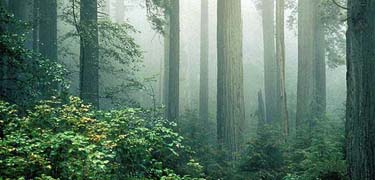
| ThE
HiStOrY | CoOl
FaCtS | NeAt PlAcEs |
Facts:Redwood National and State Parks Over the passage of time, some aspects of northwestern California Indian cultures began to merge. Many customs, beliefs, and ceremonies grew similar, but the languages have remained distinct. Four of them – Tolowa, Yurok, Hupa, and Karuk – are still living languages, spoken yet by a handful of cherished elders. Encouragingly, in a revival that is now sweeping the entire area, these languages are once again being learned by members of the younger generation. Despite the dreadful history of the past 150 years, the American Indian community of northwestern California has persisted. It has, in fact, done more than persist. Whether in politics, art, religion, or any other area of life, the community exhibits great variety and astounding vigor. There is currently no one in the area who is living the way American Indians did prior to 1850, any more than there is a member of the dominant culture who is living the life of a mid-nieteenth century miner, farmer, or merchant. While some American Indians live on reservations, near or on the land of their ancestors, others live in local towns and cities. Culture is not a "museum" set in time and statically preserved. Living cultures need to grow, change, and adapt, and this has certainly been the case with American Indian culture. Yet, while no one is living a strictly traditional life, few have wholeheartedly opted for an entirely "modern" lifestyle. Most people straddle an area between "mainstream" and their evolving American Indian culture. The people of northwestern California form a vital, changing community, whether Yurok, Hupa, Tolowa, or Karuk. Yurok and Tolowa ancestral territories include land and resources
now contained within RNSP. Today, the Yurok reservation runs from
the mouth of the Klamath River 40 miles upstream, and the Tolowa
have two rancherias in Del Norte County. |
 |
| BaCk to PaRkS |